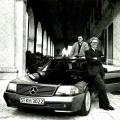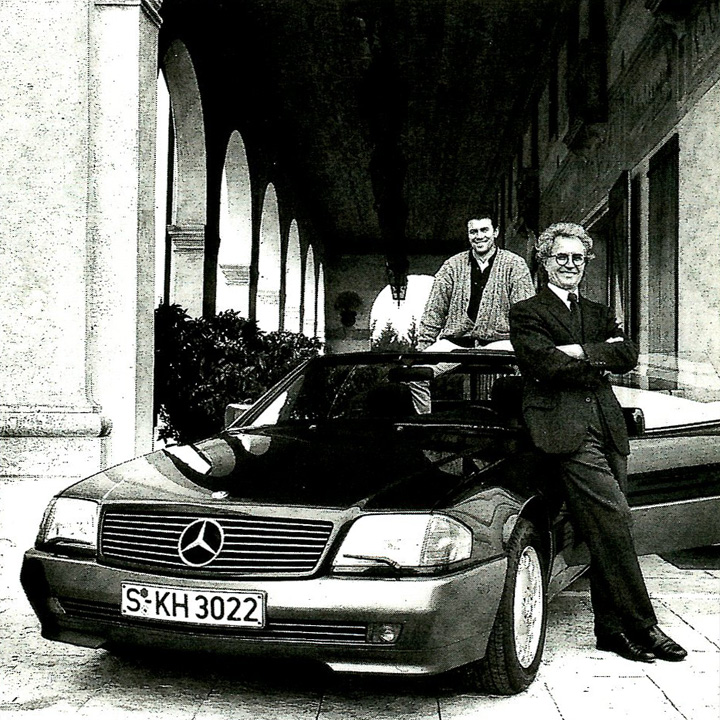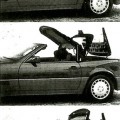-
 The Benettons
The BenettonsLa Dolce Two-Seater: The Benettons play around in a Mercedes 500SL
Vanity Fair
The allure of a Mercedes Benz roadster is impossible to overstate. Parked in the sprawling compound surrounding the Benetton family’s seventeenth-century villa north of Venice, the new 500SL attracted seamstresses, patternmakers, designers, security guards, and senior executives of the Benetton clothing empire. Even though Ferraris, Lamborghinis, and Maseratis are made in towns not very far away, and our test car was painted a depressing peat-moss green, the SL exuded an irresistible charisma.
“Mercedes-Benz has to make cars like this even if the market for them is very, very small, simply because people expect them to,” Luciano, the senior Benetton, said as he circled the source of all the attention. “This is a classic machine. The image is of very high quality, and very high technology.” Benetton, who oversees the marketing of Benetton clothes and drives an Alfa Romeo 164 sedan, spends millions of dollars each year on cars: Formula One, Team Benetton-Ford Grand Prix racing cars, which he uses to promote his company’s image the way other corporate types use actors and astronauts. Grand Prix racing is televised worldwide, and has enormous cachet in Europe because Europeans, especially younger ones, are car-and technology-hungry.

Luciano Benetton and his son Mauro with the 500SL. Only the image is conservative.
“I like older cars for myself,” Benetton said, “particularly the English ones, like the old Bentleys, Rolls-Royces, and Jaguars. But I gave up collecting them because I didn’t have the space. And because there was a time here when politically it was very hard to drive around in a Rolls-Royce or a Bentley. Socially, it simply wasn’t possible. And now, of course, there’s too much traffic. Anyway, just to drive to work, and for business, it’s better to have something new. Brakes, suspensions-everything is better now. In the Mercedes 500SL, you can go on the autostrada for five hundred or seven hundred miles and feel very safe, even in bad weather.” I could confirm that, because I’d driven the car from the Mercedes-Benz headquarters in Stuttgart, Germany, across the foggy Brenner Pass, and down to Treviso in northern Italy, the town near the Benetton estate.
“The SL is very safe and conservative,” Benetton said, “which is important. In Japan, the luxury cars are even more conservative.” Just then, by chance, a group of Japanese businessmen in dark suits stopped to ogle the car. They were coming from a meeting upstairs with Benetton executives, and asked if they could photograph the SL. Mario, Luciano’s chauffeur, blurted in Italian, “You’ll see, in a few months they will have copied it.” Perhaps, but while Japanese carmakers have been disproportionately influenced by Mercedes and BMW sedans in the recent past, no manufacturer, except for Cadillac, has ever dared copy the concept or shape of the Mercedes sports car since it was introduced in the mid-fifties. The Allante, Cadillac’s answer to the SL, continues to be a marketing failure, even though it’s an extremely refined and elegant car.
Mario, for years the family’s driver, and a bit rough around the edges, tried mightily to find fault with the SL. He claimed to see signs of tire wear, for instance, which he attributed to a stiff suspension, and he said the front end was a bit light on cornering. But even Mario conceded that the car was “better than a Ferrari.” He was impressed by the “absolutely perfect silence” inside the Mercedes. Wind noise is conspicuously absent in the SL because of an incredibly sophisticated convertible top that is wholly insulated and fully automatic. It has also become Mercedes-Benz’s current bête noire. Glitches in the top are reportedly the cause of a slowdown in the SL assembly line. (Europeans already have to wait three years to buy one.) Our car worked flawlessly, however; the sixteen little motors performed in balletic unison to lower the windows, unlatch the fabric top, swing open the cover for the hatch, dump the perfectly folded canvas into it, and raise the windows again. In less than a minute, in perfect silence, at the touch of a button. We drove without the hard top, even though the weather was brisk, because the sealing of the fabric top is superb, and because the car is equipped with a wind blocker, a screen which can be flipped up behind the passengers’ heads to rechannel the airflow and eliminate high-speed buffeting when the top is down. Mazda introduced this feature two years ago on its RX-7 convertible.
Mauro Benetton, one of Luciano’s sons, and the head of the Sisley clothing line, also spent time with the car. He drives a Porsche 91l convertible, but he was very eager to tryout the Mercedes, which he and his friends had been reading about in Italian car magazines. Mauro was impressed with its speediness, especially since the 500SL comes only with an automatic transmission, which most car-loving Italians tend to frown on. “The roll bar works fast, too,” he reported. “Twice I was speeding and the roll bar came up when I was turning and went over a pothole at the same time. It was great.” The padded roll bar is deployed whenever devices in the rear suspension sense danger.
“The instruments are classic,” Mauro went on. “They help you recognize the car as a Mercedes each time you look down.” They are also completely analog, which is a welcome relief, and gently backlit when the lights are on. Only the ambient-temperature gauge, which was extremely accurate, glared into the windshield at night. “I also liked the remote-control button for the rearview mirror,” Mauro said. “The technology in this car is incredible.” Some might call it obsessive. The SL is full of precision gizmos that are the sign of a finely calibrated machine. The sealing of the top is so good one could easily kill time at stoplights listening to the power windows whoosh up and down in their rubber braces.
The SL’s engineering is punctilious and anal; not a screw, nut, or bolt remains exposed. Even the engine compartment has an otherworldly order to it, and at the rear, no tail pipes are in evidence. Bruno Sacco, the SL’s designer, has attempted to create a car with a distinctive and organic shape that encourages the driver to think about driving not about Nakamichi CD players, burled walnut, or tufted leather. The cabin is pure Mercedes-ville, sans nationality, and worlds away from Jaguar’s English club and Infiniti’s Kyoto hotel suite. Fortunately, the SL’s handling is so informative and involving that the driver doesn’t need distractions. The suspension is firm enough to take corners quickly, calmly devour the autobahn at 155 m.p.h., and still provide a comfortable ride around town-without the help of the ever popular computer assists to set the suspension damping. Minds were at work here, not microchips.
Luciano Benetton had said that he thought the SL might not appeal to a young crowd, but his son, who is in his late twenties, seemed to think otherwise. “Only the image of the Mercedes is conservative, not the car,” Mauro said firmly. “The front is incredibly new; maybe the back is too old-style Mercedes-Benz, but together they are great. ” Mauro agreed that the SL would appeal to older types also. “I think for a lady especially it is a very easy car to drive — it’s sporty, but it isn’t a sports car. ” This could be a cue for Hollywood wives, who more than anyone are responsible for having extended the life of the previous Mercedes convertible, the 560SL, for almost as long as their own.
“Treviso is a good city to tryout the SL; you can find Porsche speedsters, Ferraris — it’s full of rich cars,” Mauro had told me when I arrived. This is definitely another “rich car.” It comes in two versions; the $73,000 300SL and the $83,500 500SL that we drove. The cars look identical, except for the rear badging, but the 500SL has a larger engine and a different transmission. The bigger motor will probably be of use only on the autobahn, where one needs the extra horsepower to propel this heavy car from 125 m.p.h. to 140 m.p.h. in order to rocket past the old SL. MG
published May 1990

